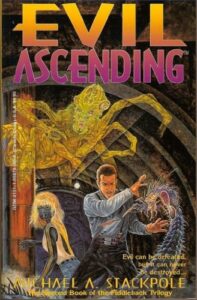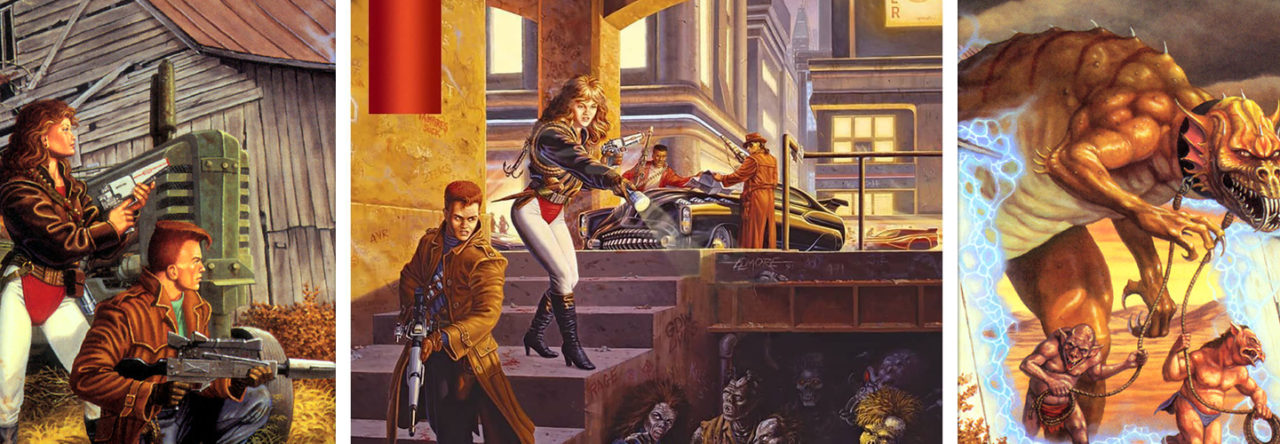… “Fiddleback is but one of many. Pygmalion, DeadTongue, Baron Someday and a dozen others all operate here on Earth. Fiddleback has been the most ambitious to date, but all are effective in their spheres of influence” …
Evil Ascending is the sequel to Michael Stackpole’s A Gathering Evil and the second novel in Dark Conspiracy’s Fiddleback trilogy. Be warned spoilers follow!
Plot Summary
 Set in the immediate aftermath of the events detailed in A Gathering Evil, Evil Ascending continues the adventures of Tycho Caine (now known by many names, including Michael Loring and Coyote) in the fight against his old master, the Dark Lord Fiddleback. Having successfully thwarted the Dark One’s plan to use the Phoenix Transport Loop as a dimensional doorway into Earth’s reality, Caine and his allies now look to strike back at Fiddleback in any way they can. To achieve this goal, new allies will be discovered, and new enemies revealed, in a mixing pot of stories that sees the novel span the world – from Arizona to Tibet, and finally to Tokyo, Japan.
Set in the immediate aftermath of the events detailed in A Gathering Evil, Evil Ascending continues the adventures of Tycho Caine (now known by many names, including Michael Loring and Coyote) in the fight against his old master, the Dark Lord Fiddleback. Having successfully thwarted the Dark One’s plan to use the Phoenix Transport Loop as a dimensional doorway into Earth’s reality, Caine and his allies now look to strike back at Fiddleback in any way they can. To achieve this goal, new allies will be discovered, and new enemies revealed, in a mixing pot of stories that sees the novel span the world – from Arizona to Tibet, and finally to Tokyo, Japan.
Quite simply, Evil Ascending feels like the middle novel of a larger series which it is, building on the background and events of the first, while hinting at what is to come in the trilogy’s finale. While that definitely results in a slight feeling of the main plot treading water at times, it does much to allow for the world of Dark Conspiracy to be better fleshed out for the reader (especially those who may not be fans of the roleplaying game). Unlike the first novel, rather than a single, first person narrative, here we have three concurrent subplots being progressed, two of which focus on new characters to the series, Sinclair MacNeal, the son of Phoenix tycoon Darius Sinclair (who was briefly encountered in A Gathering Evil), and Rajani, an member of an extraterrestrial species, who just happens to have been born here on Earth,
The simplest of these narratives is the third, that of Tycho Caine’s (the protagonest of the first novel), who having recently broken free of Fiddleback’s influence now looks to discover more about his skills and talents. To enable this he is taken to the hidden Tibetan fortress of Kanggenpo, where he learns of dimensional travel and regains the use of forgotten powers from the monks that taught another of the book’s return characters, Damon Crowley, decades earlier. As mentioned this is the most straight forward of the three plots in the novel, with Coyote discovering secrets not only about himself but also mysteries lay hidden deep within within the temple; a journey which resembles something similar to Luke Skywalker’s in The Empire Strikes Back movie.
The second plot is that of Sinclair ‘Sin’ MacNeal’s investigations into Caine’s past life in Tokyo, where, as Fiddleback’s assassin, he learnt and trained to be an instinctive killer. Here Sin learns of the otherworldly threats facing Earth and is drawn into a mission to ensure that none other than the grandson of Emperor himself does not become a pawn in the very conspiracies Coyote and his allies fight so hard against.
The final storyline focuses on Rajani, a member of an alien race known as the Jes’da, who has been placed in hibernation in attempt to strengthen herself in the hopes of defeating Fiddleback in the future. Awoken early from her slumber, by the Dark One’s failed attempts in pass through into Earth’s dimension, she travels from the US military’s secret base at Area 51, Nevada all the way to Phoenix, Arizona in the hopes of finding Coyote and his friends (obvious allies in the fight against Fiddleback). In this journey, she learns of the horrors – both alien and manmade – that have come to pass in the world, and it is through her actions and abilities the various threads of the novel are brought together in the end.
The climax of the novel sees all of the Minion Hunters (and their allies) gather at Caine’s old training ground in Toyko, looking to combine their efforts in an attempt to destroy Fiddleback’s link to our reality once and for all. This however, is not as easy as it is sounds, and although they are reinforced by Vikram, the Yidam (demon guardian) of Kanggenpo (who – long story – also turns out to be Rajani’s father), as well as members of the Japanese Yakuza, and ninja’s of the Emperor’s Internal Defence Cadre, it is only with the arrival of another Dark Lord, Pygmalion, that the forces of Fiddleback defeated. Of course, nothing is ever that easy, with Pygmalion soon departing untouched, taking with him the ultimate prize of Ryuhito, the Emperor’s Grandson within whom the blood of ancient gods resides.
In the end, its seems that even the combined forces of humanity cannot ever hope to defeat the Dark Lords of the other dimensions, and Coyote is left wondering if the only option left to secure a future for humanity is to ally with the very evil who for so long has been his greatest enemy…
My Thoughts
It has probably come across in the plot summary, but this is my least favourite of Fiddleback Trilogy novels. The entire book really does feel like a ‘set-up’ for the finale. Sure, it works to build on the plot provided in the first book, but it never really has the time or space to development the three main story threads into the very well structured plot.
I think part of the issue I have here is that each of the three narratives (Coyote in Tibet, Sin in Japan and Rajani’s trip to Phoenix) could have easily been a full novel in their own right. Sin’s adventure especially seems short changed, with his investigations being very much a ‘by the numbers’ story, which poses no real mystery, threat or discovery in his task to discover the old home of Tycho Caine in Toyko. Likewise, Coyote’s own story isn’t the most engaging, even though the place in which it unfolds is interesting in its own right. To me, it’s Rajani’s journey through Nevada and Arizona that represent the best bits of the book, with the reader getting to see not only the impact of Demonground infecting the land, but also the rising influence of the corporations and their power over the population (the early side story covering her trip to Flagstaff with the children Mickey and Dorothy are some of the most interesting scenes). That might sounds harsh, but it probably reflects the author’s attempt to grow a trilogy out of what was initially going to be a single-novel plot; he had to expand the narratives created in the first novel, while introducing new challenges and threats for the characters, a process that – but default – dilutes the previously tight structure of the overall story.
That said, there is lots to like from the novel. It is great to see the world of Dark Conspiracy fleshed out, especially outside of America, and the two main characters introduced – Sinclair and Rajani – are both great additions to the trilogy (I love the explanation as to why the aliens came to Earth and why/how they were corrupted by the Dark Ones, and more over why Rajani’s father is now a four-armed, black-skinned elephant demon!). Let’s be honest, anything written by Michael Stackpole is an enjoyable read, his ability to drive a fast paced plot (as needed with a book that is only 310 pages of fairly-large print), while still allowing space for character development, is unique in the world of RPG novelizations (probably only bettered in recent times by the likes of the fantastic Dan Abnett).
To summarise, without a doubt, Evil Ascending is a fun, if flawed, novel, with some great characters and snappy writing, but that is – sadly – a shadow of its predecessor. While I might not be overly enamoured by this book, as a whole (and as I’m sure I’ve said before) the Fiddleback Trilogy will always be special to me. Not only do these books inform much of my own vision of the Dark Conspiracy setting – especially in the narrative and structural sense – but getting to read any fiction for one of your favourite RPGs is always a pleasure!

